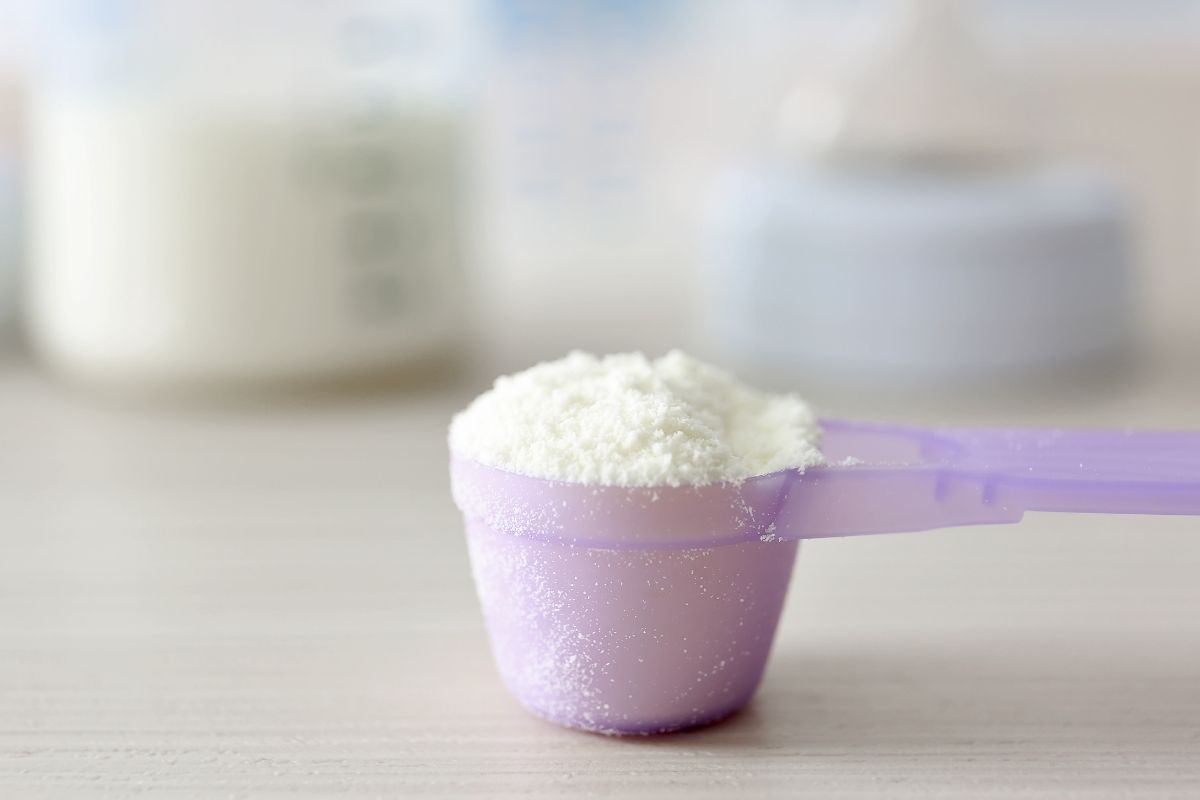
As a new mom, you have probably heard from several people that only breast milk is best. Undoubtedly, breast milk is nutritionally optimal for babies, but for many moms, exclusively breastfeeding is not always possible or realistic.
If you find yourself in this boat, you might think you have to choose between breast or bottle-feeding your baby, but as it turns out, you can do both! It’s called combination feeding, and it’s a common practice in which moms breastfeed and use formula.
But before jumping straight into mixed feeding, there are some essential things to consider which we’ll walk you through in this blog!
Table of content
- What is Combination Feeding?
- When is Combination Feeding a Good Option?
- What do You Need to Know Before Deciding to Switch to Mixed Feeding?
- How Might Your Breastfed Baby React to Being on Their First Formula?
- Top Tips on Making The Transition to Combination Feeding Easier
- What to Considering When Selecting the Best Formula for Your Baby
- Finding The Right Organic Infant Formula
- Conclusion
What is Combination Feeding?
If you’re new to this topic, nourishing your baby with breast milk and infant formula is a practice known as combination feeding (a.k.a combo, mixed, or supplemental feeding). It’s done in several ways, including combining breast milk and formula together, giving one after the other, or alternating between the two!
If you are considering trying out breast and bottle feeding it’s important to speak with a healthcare professional first to help you determine if it’s the right choice for you and your baby. We examine why mothers start mixed feeding in the next section!
When is Combination Feeding a Good Option?
When your little one was still in the womb, you likely dreamed up a picture-perfect idea of how you planned to feed your child, but once you welcome your baby into the world, things don’t always fit that fantasy.
When things don’t go as planned, it’s normal to feel disappointed, but the good news is that there are plenty of options to help ensure your baby is happy, healthy, and well-nourished (and it’s more than okay to ask for a helping hand in the feeding department)!
Combination feeding is just one alternative for mothers unable to produce enough breast milk to meet their baby’s nutritional needs through exclusive breastfeeding. Plus, it can take the weight off moms craving more flexibility and convenience in their feeding routines.
Here’s a list of typical reasons that lead moms to choose combination feeding:
- They struggle to establish exclusive breastfeeding
- They returned to work and are unable to pump or nurse in the workplace
- They want to share the responsibility of their baby’s feeds with their partner
- They changed their mind about bottle feeding and want to start nursing
Beyond these situations, it could be medically necessary combo feed; usually, in these cases, mixed feeding is only needed temporarily and mothers can eventually return to breastfeeding exclusively.
If any of the scenarios listed below apply to your little one, your baby’s doctor may recommend that you supplement feedings with formula:
- Your baby is struggling to gain weight adequately
- Your baby has a low birth weight (less than 1500 gm)
- Your baby was born very prematurely (under 32 weeks)
- Your baby is suffering from an illness
In reality, moms predominantly turn to mixed feedings for practical or emotional reasons because let’s be honest, breastfeeding is rewarding but hard work!
If you struggle with breastfeeding complications like low milk supply you should know that combination feeding is not your only option. It’s a good idea to chat with your physician or lactation consultant to help get your nursing back on track before turning to mixed feeding.
What do You Need to Know Before Deciding to Switch to Mixed Feeding?
How you choose to feed your baby is a deeply personal decision that requires a lot of careful consideration. Be mindful that combination feeding has its unique implications, benefits, and drawbacks.
Impacts on Breast Milk Supply
First and foremost, be aware that regularly supplementing with formula could make it more difficult for you to continue nursing by interfering with your milk supply. For this reason, it’s best to work with healthcare professionals who can offer guidance on how much formula to feed your baby and how to increase your milk supply if necessary.
Ideally, you should start mixed feeding after establishing a successful breastfeeding routine and a good milk supply because this can help smooth the transition for you and your baby. Gradual transitions give your body time to slow down milk production and decrease the risk of overfull breasts and mastitis.
How Might Your Breastfed Baby React to Being on Their First Formula?
Switching between different feeding methods may affect your baby’s sleep patterns and digestion, so be prepared for possible changes in these areas. One of the most common reactions is a change in sleep patterns.
Due to their new diet, many babies will start sleeping for longer at night or taking more naps during the day. While this isn’t necessarily a bad thing, it can be an adjustment period for you and your family.
You know the saying you are what you eat? Well, in the case of baby poop, this is very true. Breastfed babies and formula-fed babies have different bowel movements. Breastfed babies tend to poop more often than formula-fed babies. Beyond frequency, it’s normal to notice a change in the colour, smell, and consistency of your baby’s poop when transitioning to supplemental feeding.
Babies are also creatures of habit. So, when you switch up feeding methods, they might become finicky. More specifically, if your baby is used to being fed from a bottle of formula and not from your breast, they might develop a preference for bottles and refuse the breast. The opposite is also true. If you have an exclusively breastfed baby, they might refuse a bottle even after trying several nipples, positions, and flows.
Patience, persistence, and lots of trial and error are usually enough to get your baby to accept both breast and bottle. But if your baby is adamantly resisting the change, a lactation expert can be your best friend.
Digestive discomfort is another potential side effect of introducing formula into babies’ diets, often resulting in constipation and gas. This is oftentimes due to babies swallowing more air bubbles when feeding from the bottle than the breast.
Air bubbles get trapped in their tummies and cause gas and discomfort. You can help your baby release air bubbles by burping them more often during or after feedings. You can also help avoid tummy troubles by opting for a gentle formula; we’ll discuss tips for finding the best formula later.
Top Tips on Making The Transition to Combination Feeding Easier
Every feeding journey is different, for some parents, the transition to mixed feedings is easy as ABC, but others are not so lucky and may have to try a few different strategies to help their baby adjust to the change. Read on for our suggestions for finding the best feeding equipment for your baby, from nipples to pumps, and how to position your baby to encourage acceptance of feedings.
How to Choose The Best Bottle
There is an abundance of bottles to choose from (this could be in an entire article in itself). From your standard plastic reusable bottle to anti-colic bottles and even bottles that connect directly to your breast pump, when it comes to bottles, you have more options than you could ask for.
The best bottle for your little one is unique to your baby’s needs and preferences. Considerations include: how budget friendly a bottle is, how convenient it is to clean, and if it’s environmentally friendly! In general, look for a bottle that fits comfortably in your child’s mouth and is easy for their wee hands to grip so they can drink comfortably.
How to Choose The Best Nipple
Keep in mind that not every bottle and nipple are compatible. If you opt for a special kind of bottle, say a breast-mimicking bottle, it could be harder to find a nipple that fits. Compatibility aside, a nipple should be comfortable for your baby and age-appropriate. Too small of a nipple will cause them to suck too hard, which could lead to choking, while too large of a nipple could result in milk spilling out before they have time to swallow it properly.
The Right Position for Breastfeeding and Bottle feeding
Contrary to misconceptions, both breast and bottle feeding are opportunities to bond with your baby. If possible, try to find a position that mimics breastfeeding as much as possible so your baby can adjust to the new experience with less difficulty. The National Health Service recommends holding your baby close to you in a semi-upright position with head support to allow them to breathe and drink safely and comfortably.
Why You Should Try Out a Breast Pump
Finally, having a good quality breast pump can be a lifesaver! Pumps can help you maintain or boost your breast milk supply (which is essential to mixed feeding). They can also relieve soreness from full breasts, and if you struggle with inverted nipples, they can help pull them back out so your baby can nurse more easily! With a pump, you can express now and feed later; pumped milk stays good for 3 to 5 days in the fridge and up to 6 months in the freezer!
What to Considering When Selecting the Best Formula for Your Baby
If you’re a newbie to the world of infant formula, you know how overwhelming it can be. Odds are you either never heard of or are unaware of the importance of many of the ingredients found in infant formula. And do not get us going on the stress of choosing between different brands and types of formula.
You’ve likely been warned by seasoned formula-feeding parents that you may have to go through several to find one that works for your baby. Finding a formula is no easy feat so give yourself a break and consult your pediatrician for guidance. We’ll cover some points to consider on your hunt for formula next!
The Price of Baby Formula
One of the many benefits of breast milk is that it’s free, a luxury that does not exist for formula feeding. Depending on what type you choose and where you purchase it from, it can range steeply in cost. Be sure to factor cost per oz into your decision-making process since this could impact your baby budget significantly.
Store-brand formulas are more cost-effective but may contain ingredients some parents prefer to avoid, such as GMOs or corn syrup. Meanwhile, an organic baby formula can be more natural and environmentally friendly but is often more expensive.
Infant Formula Shortage
We wish this were an issue we could skip over, but 2022 was a big eye-opener about how dependable the formula supply can be. It’s a good idea to stay informed about potential baby formula shortages or recalls in your area that could impact your ability to source the formula that your baby depends on.
It’s also worth researching if and how the formula brand you’re interested in works to protect their customers against shortages and what they do to ensure their formula is up to spec to avoid recalls.
Finding The Right Organic Infant Formula
It’s important to note that all baby formulas satisfy the nutritional needs of babies; the choice between a standard or organic infant formula comes down to personal preference and values. While organic formulas are usually more expensive than regular formulas, they also offer unique benefits.
An organic formula may have the advantage of being a greener choice as organic regulations place restrictions on the use of chemical pesticides, herbicides, and fertilizers in farming. Organic milk can also ensure improved animal welfare. For example, some organic certifications prohibit cruel practices like the dehorning of animals, and the use of growth hormones, and animals may receive greater access to the outdoors.
In terms of composition, organic formulas tend to use more pure and natural ingredients which is accomplished by prohibiting more controversial ingredients such as GMOs, artificial sweeteners, aroma or flavor enhancers, and colorants.
Conclusion
Combination feeding can offer parents greater feeding flexibility while continuing to provide breast milk for their baby. While combo feeding works well for some families, it is not the right choice for everyone. Before combining breastfeeding with bottle-feeding formula, it’s best to speak with a physician or lactation consultant to help you find a feeding solution that works for you and your little one.
Frequently asked questions
Related articles

- /
Breastfeeding Tips for a Successful Start

- /










